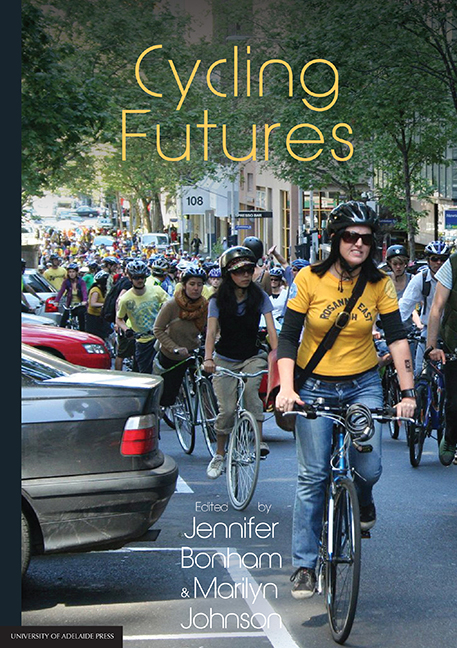Book contents
- Frontmatter
- Contents
- Preface
- Editors
- Contributors
- PART I Current challenges
- PART II Strategies for change
- 9 Gender and cycling: Gendering cycling subjects and forming bikes, practices and spaces as gendered objects
- 10 Making (up) the child cyclist: Bike Ed in South Australia
- 11 More than a message: Producing cyclists through public safety advertising campaigns
- 12 Spaces for cycling
- 13 Off-road cycling infrastructure
- 14 Teaching Australian civil engineers about cycling
- 15 What should planners know about cycling?
- 16 Skilling landscape architects and urban designers for design of bicycle parking and network facilities
- 17 Cycling and Australian law
11 - More than a message: Producing cyclists through public safety advertising campaigns
from PART II - Strategies for change
Published online by Cambridge University Press: 25 July 2017
- Frontmatter
- Contents
- Preface
- Editors
- Contributors
- PART I Current challenges
- PART II Strategies for change
- 9 Gender and cycling: Gendering cycling subjects and forming bikes, practices and spaces as gendered objects
- 10 Making (up) the child cyclist: Bike Ed in South Australia
- 11 More than a message: Producing cyclists through public safety advertising campaigns
- 12 Spaces for cycling
- 13 Off-road cycling infrastructure
- 14 Teaching Australian civil engineers about cycling
- 15 What should planners know about cycling?
- 16 Skilling landscape architects and urban designers for design of bicycle parking and network facilities
- 17 Cycling and Australian law
Summary
Introduction
Despite the burgeoning field of cycling research and widespread concerns over media representations of cyclists (Horton, 2007; Skinner & Rosen, 2007; Advertising Standards Bureau, 2011) very little academic work has been published on cycling and the media. A few notable exceptions include Zac Furness's (2010) detailed account of cycling in North American popular culture (film, literature and television), Ben Fincham's (2007) discussion of bike messengers in the British press, and the comparative study of representations of cyclists in Australian newspapers by Rissel, Bonfigliolo, Emilsen, and Smith (2010). The limited scrutiny of cycling in the Australian media contrasts with the recent spate of government-sponsored road safety advertising campaigns which feature cyclists (for example, ‘Share the road’; ‘Be safe be seen’; ‘It's a two-way street’). Many of these campaigns aim at fostering more positive interactions between cyclists and motorists. In this chapter, we are specifically interested in a road safety campaign which features cyclists as a point of contrast in its advice to young drivers.
Young drivers are often targeted in road safety campaigns because of their over-representation in road crash statistics (Bureau of Infrastructure, Transport and Regional Economics [BITRE], 2013a; Wundersitz, 2012; Curry, Hafetz, Kallan, Winston, & Durbin, 2011). In 2012, people aged 17-25 made up just 13% of the Australian population yet accounted for 22% of fatalities on Australian roads (BITRE, 2013b, p. iii). Graduated licensing systems and mass media advertising campaigns are two interventions used by Australian state and territory governments to address high crash rates amongst young people. Although a number of evaluative studies have questioned the efficacy of mass advertising campaigns (for example, Ulleberg, 2001, p. 293; Delaney, Lough, Whelan, & Cameron, 2004; Wundersitz, Hutchinson, & Woolley, 2010), they remain an important part of the road safety tool kit. The current chapter analyses the road safety advertising campaign screened by the South Australian Motor Accident Commission [MAC] from 2010 to 2014. We are specifically interested in the characteristics and behaviours assembled together under the term ‘cyclist’ in the MAC campaign.
- Type
- Chapter
- Information
- Cycling Futures , pp. 229 - 250Publisher: The University of Adelaide PressPrint publication year: 2015



